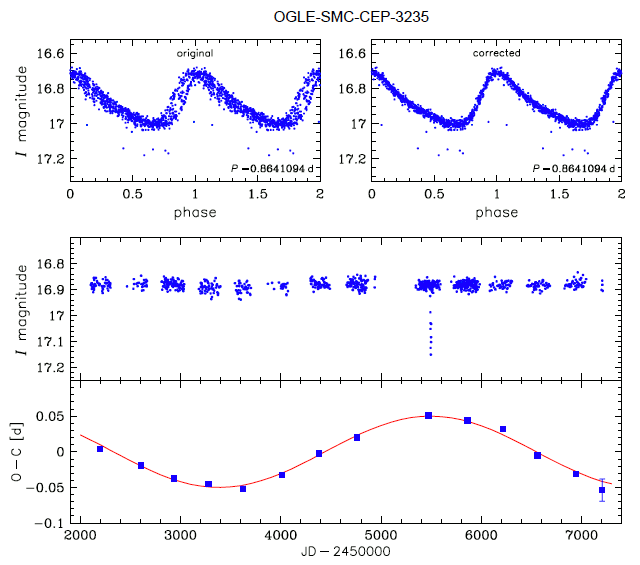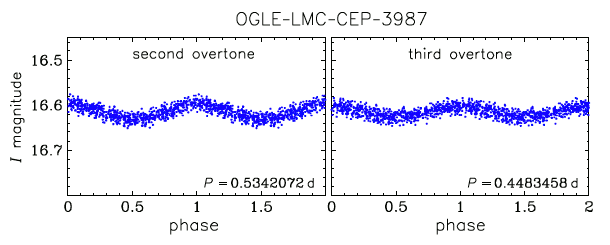The OGLE Collection of Variable Stars
Classical Cepheids in the Magellanic System
I. Soszyński, A. Udalski, M. K. Szymański, G. Pietrzyński, Ł. Wyrzykowski, K. Ulaczyk, R. Poleski, P. Pietrukowicz, S. Kozłowski, J. Skowron, D. Skowron, P. Mróz, M. Pawlak
Acta Astronomica, 65, 297 (arXiv:1601.01318)
"Multi-Mode and Non-Standard Classical Cepheids in the Magellanic System",
I. Soszyński, A. Udalski, M. K. Szymański, R. Poleski, P. Pietrukowicz, S. Kozłowski, P. Mróz, Ł. Wyrzykowski, D. Skowron, J. Skowron, G. Pietrzyński, K. Ulaczyk, M. Pawlak
Acta Astronomica, 65, 329 (arXiv:1601.02020)
"Eclipsing Binaries with Classical Cepheid Component in the Magellanic System",
A. Udalski, I. Soszyński, M. K. Szymański, D. Skowron, G. Pietrzyński, R. Poleski, P. Pietrukowicz, J. Skowron, P. Mróz, S. Kozłowski, Ł. Wyrzykowski, K. Ulaczyk, M. Pawlak
Acta Astronomica, 65, 341 (arXiv:1601.01683)
We present a nearly complete census of classical Cepheids in the Magellanic System. The sample extends the set of Cepheids published in the past by the Optical Gravitational Lensing Experiment (OGLE) to the outer regions of the Large (LMC) and Small Magellanic Cloud (SMC). The entire collection consists of 9535 Cepheids of which 4620 belong to the LMC and 4915 are members of the SMC. We provide the I- and V-band time-series photometry of the published Cepheids, their finding charts, and basic observational parameters.

Based on this unique OGLE sample of Cepheids we present the updated period-luminosity relations for fundamental, first, and second mode of pulsations in the I and V bands and for the WI extinction-free Wesenheit index. We also show the distribution of classical Cepheids in the Magellanic System.

The OGLE collection contains several classical Cepheids in the Magellanic Bridge - the region of interaction between the Magellanic Clouds. The discovery of classical Cepheids and their estimated age confirm the presence of young stellar population between these galaxies.

We present a census of eclipsing binary systems with classical Cepheid as a component. All such systems known were found in the OGLE collection of classical Cepheids in the Magellanic System. We extend the list of potential candidates adding four new objects found in the OGLE-IV photometric data. One of the new Cepheids in the eclipsing system revealed only one eclipse during 15 years of the OGLE photometric monitoring. However, it additionally shows very well pronounced light-time effect indicating that the binarity is real. We also search for the light-time effect in other known eclipsing cepheids and we clearly detect it in OGLE-LMC-CEP-1812. We discuss application of this tool for the search for Cepheids in non-eclipsing binary systems.

The sample contains the first known double-mode Cepheid pulsating in the second- and third-overtone modes and a large number of objects with non-radial modes excited. We also found Cepheids revealing Blazhko-like light curve modulation, objects ceasing pulsations or showing atypical shapes of their light curves.

All photometric data is available from the OGLE Internet Archive
PLEASE cite the following papers when using the data or referring to these OGLE results:Soszyński et al., 2015, Acta Astronomica, 65, 297 (arXiv:1601.01318)
Soszyński et al., 2015, Acta Astronomica, 65, 329 (arXiv:1601.02020)
Udalski et al., 2015, Acta Astronomica, 65, 341 (arXiv:1601.01683)
Any comments about the data and the form of their presentation are welcome as they can improve the future releases of OGLE analysis. Send your messages to this address.
 back
back